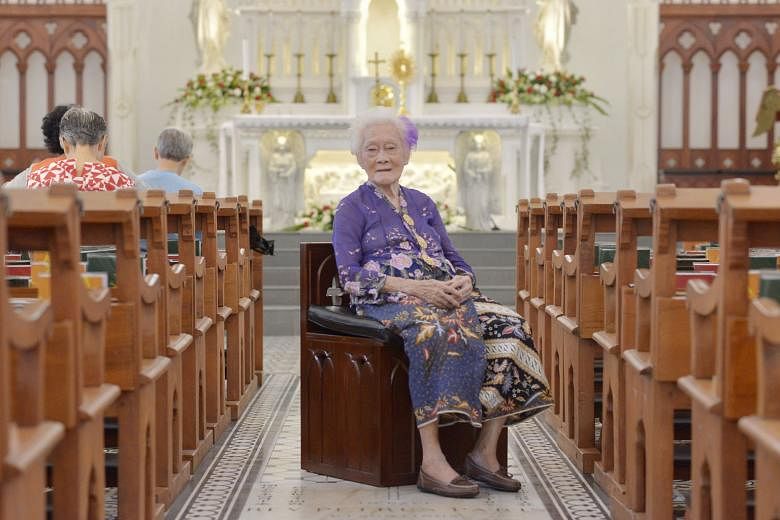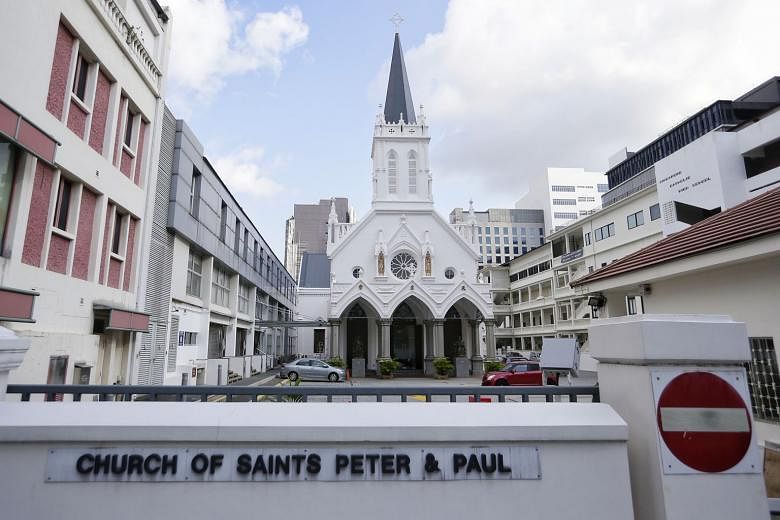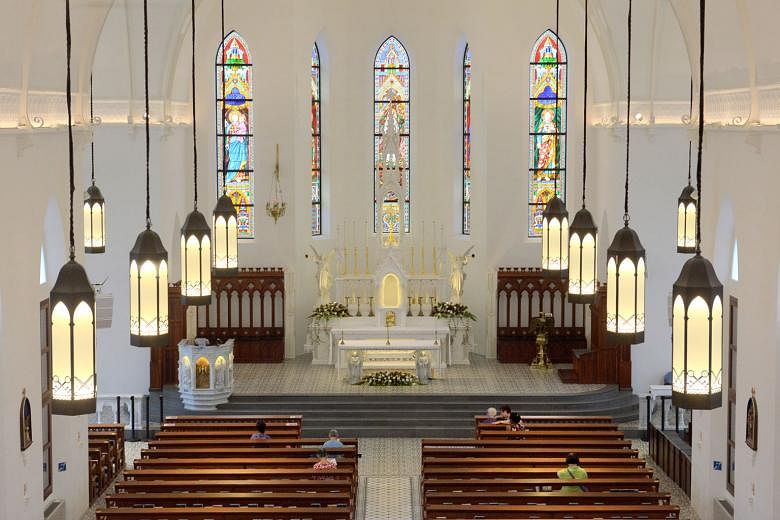With a purple streak in her powder white hair, 96-year-old Madam Theresa Lai An Noi sits every day at the front of the Church of Saints Peter and Paul for service.
Churchgoers know her as Auntie Seet. She has given more than 70 years of her life to the church that is also home to her.
The original church was completed in 1870, but underwent numerous extensions and renovations over time. Most recently, an $8 million, year-long restoration was completed in 2016.
But Madam Lai's story with the church started in 1936, when she came to Singapore from Bukit Mertajam, Penang, Malaysia, as a 15-year-old orphan.
Soon after, she started caring for the church. She became a sacristan when she was 28. A sacristan performs several duties such as arranging sacred items for mass and taking care of the ringing of bells that announce the celebrations.
Father Michael Seet, who used to serve at the Church of Saints Peter and Paul, had brought her to Singapore to help care for his ailing sister-in-law.
Father Seet was the first Chinese priest to be ordained in Singapore in 1911 and served at the church for two years before moving to the St Anne's Church in Penang.
He saw Madam Lai at an orphanage in Bukit Mertajam that was run by nuns and brought her to Singapore in 1936 where the rest of his family still lived. Madam Lai lived with the Seet family in one of the 11 houses on the church grounds when she came to Singapore.
The houses were built on land adjoining the church on Queen Street by prominent Chinese Catholic Joseph Chan Teck Hee in 1897 to accommodate widows, catechists and the aged.
Some of the houses were torn down in 1935 to build the original Catholic High School, and the Seet family lived in one of the remaining houses.
-
THROUGH THE YEARS
-
1870
Original church was completed.
1936
Madam Lai came to Singapore from Bukit Mertajam, Penang, Malaysia, as a 15-year-old orphan. She started caring for the church and became sacristan.
1945
Madam Lai married Mr Francis Seet, also a sacristan. The couple and their three children lived on the church grounds.
2003
The church was gazetted as a national monument on Feb 10.
2016
Most recent restoration works, costing $8 million completed after a year.
While living there, Madam Lai soon found herself falling for Mr Francis Seet, Father Seet's nephew, also a sacristan.
On July 2, 1945, she became Mrs Theresa Seet and they lived on the church grounds. It was during the Japanese Occupation and the church was a place of refuge for those living nearby.
Mr Seet and Madam Lai went on to have three children: Mr Lawrence Seet, 71, Madam Mary Seet, 68, and Mrs Josephine Seet- Tan, 65.
All three siblings, like their parents before them, were married at this church.
Mr Lawrence Seet is now the sacristan of the church, taking over from his mother when she could no longer carry out the duties at the age of 85.
The church was gazetted as a national monument on Feb 10, 2003.
It was built when the nearby Cathedral of the Good Shepherd, also on Queen Street, could no longer accommodate a growing number of Chinese and Indian Catholics.
In 1858, Reverend Father Pierre Paris, a priest from the Society of the Foreign Missions of Paris (MEP) who was proficient in several Chinese dialects and Tamil, was assigned to head the Chinese Mission and attend to the Tamil-speaking Catholics.
In 1883, he purchased and installed three bronze bells in the belfry that are still in use today.
He died in May that same year before he could witness the blessing of the bells, and is buried in the central aisle of the church.
In 1888, the Church of Our Lady of Lourdes at Ophir Road was completed to serve as the base of the Tamil Mission. The Tamil Catholics then moved there for services.
The Church of Saints Peter and Paul became exclusively for the Chinese Catholics after this movement, and catered to their language needs by serving mass in dialects as well as in Mandarin.Today, the church conducts most services in English, with Mandarin and Cantonese mass held once a week on Sundays.
Father Edward Lim, parish priest of the church, said the number of people turning up for the Mandarin and Cantonese masses has dwindled.
He said: "The younger generation of Singaporeans just tend to prefer English. The Mandarin and Cantonese mass definitely still has older locals attending, but it has become more for foreigners nowadays. The languages faded away, and with them so did the services."
Father John Chua, a priest who has served at the church for six years, said the church is struggling to attract young people.
He said it used to be that people would come from the nearby residential areas but now the church is surrounded by towering steel offices instead of the houses and schools that were once its lifeblood.
Ms Nessie Mok, 42, who is in the executive committee of the Parish Pastoral Council, said that, although there are some Housing Board blocks in the area, most of them tend to have older folk.
So, they have a hard time attracting younger members, and rely heavily on family ties, she added.
"A lot of people come here because their mothers and fathers came here and were married here. Then they get married here, have children and bring them to the church," she said.
She added that they do get new devotees from the nearby Singapore Management University. "But, at this church, family really is the cornerstone of our congregation."
Like the Seet family, and their mother who is ready to welcome people to the church that they call home.



